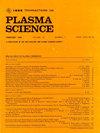半导体开路开关的实验与数值模拟研究
IF 1.5
4区 物理与天体物理
Q3 PHYSICS, FLUIDS & PLASMAS
引用次数: 0
摘要
本文研究了半导体开关(SOS)二极管中大电流的纳秒中断,旨在弥合实验结果与数值模拟之间的差距。在300 a /cm2 ~ 5 kA/cm2的截止电流密度范围内,给出了SOS二极管(0.25 cm2, 0.9 kV)作为纳秒型断流器的实验结果,分析了漂移阶跃恢复二极管(DSRD)和SOS两种工作模式。此外,利用Synopsys TCAD软件对SOS二极管进行了数值模拟,研究了SOS二极管在DSRD和SOS模式下的动态特性。利用带电路模拟器的混合模式器件模拟SOS效应和电流截止阶段发生的动态过程。最后,对SOS电流和负载电压的实验和数值模拟结果进行了比较,表明:1)TCAD模型在市售软件中的准确性;2)SOS二极管在DSRD模式下工作的可能性。本文章由计算机程序翻译,如有差异,请以英文原文为准。
Experimental and Numerical Simulation Study of a Semiconductor Opening Switch
This article examines the nanosecond interruption of high current in semiconductor opening switch (SOS) diodes, with the goal of bridging the gap between experimental results and numerical simulations. The experimental results of SOS diodes (0.25 cm2, 0.9 kV) operating as a nanosecond interrupter are presented in a wide range of cut-off current density from 300 A/cm2 to 5 kA/cm2 to analyze the two modes of operation, i.e., drift step recovery diode (DSRD) and SOS. In addition, the numerical simulations of the SOS diode are conducted to investigate the dynamics of the SOS diode in the DSRD and the SOS modes using the Synopsys TCAD. A mixed-mode device with a circuit simulator is utilized to simulate the SOS effect and the dynamic processes occurring during the current cut-off stage. Finally, the experimental and numerical simulation results of the SOS current and load voltage are compared indicating: 1) the accuracy of the TCAD model in the commercially available software, and 2) the possibility of operating the SOS diode in a DSRD mode.
求助全文
通过发布文献求助,成功后即可免费获取论文全文。
去求助
来源期刊

IEEE Transactions on Plasma Science
物理-物理:流体与等离子体
CiteScore
3.00
自引率
20.00%
发文量
538
审稿时长
3.8 months
期刊介绍:
The scope covers all aspects of the theory and application of plasma science. It includes the following areas: magnetohydrodynamics; thermionics and plasma diodes; basic plasma phenomena; gaseous electronics; microwave/plasma interaction; electron, ion, and plasma sources; space plasmas; intense electron and ion beams; laser-plasma interactions; plasma diagnostics; plasma chemistry and processing; solid-state plasmas; plasma heating; plasma for controlled fusion research; high energy density plasmas; industrial/commercial applications of plasma physics; plasma waves and instabilities; and high power microwave and submillimeter wave generation.
 求助内容:
求助内容: 应助结果提醒方式:
应助结果提醒方式:


